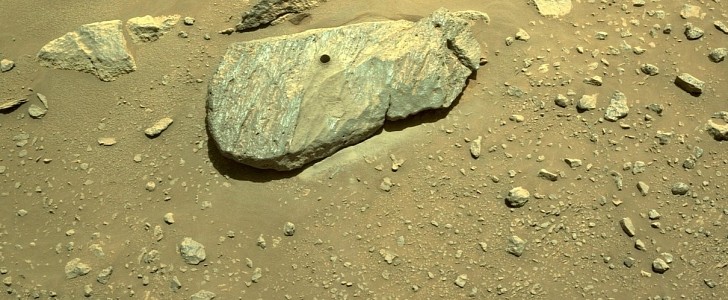On September 1st, NASA's Perseverance team has received a set of images that indicate successful coring. However, scientists are awaiting further data from the rover before confirming the achievement. This is the second such effort for Perseverance after its first attempt came up empty on August 6th.
Following its failed attempt, the rover drove 1,493 feet (455 meters) away to a new location called "Citadelle" (French for "castle"). Citadelle is covered by a layer of rock that seems to resist wind erosion, indicating that the rover's second effort might be successful.
Using a percussive drill at the end of its 7-foot-long (2-meter-long) robotic arm and a hollow coring bit, Perseverance got to drilling. The initial images took by the rover with its onboard camera after coring show an intact sample present in one of the sample tubes located inside its belly.
However, NASA claims that additional photos obtained after the rover finished sample gathering were inconclusive due to poor lighting conditions. Therefore, another round of images with better lighting needs to be taken before declaring Perseverance's second attempt a success.
If the results of the second set of images are still inconclusive, the Perseverance team has a few alternatives for moving forward, including using the volume probe of the Sampling and Caching System (placed inside the rover's chassis) as a final confirmation of the sample being in the tube.
"The project got its first cored rock under its belt, and that's a phenomenal accomplishment," said Jennifer Trosper, project manager at NASA's Jet Propulsion Laboratory. "The team determined a location and selected and cored a viable and scientifically valuable rock. We did what we came to do. We will work through this small hiccup with the lighting conditions in the images and remain encouraged that there is a sample in this tube."
Using a percussive drill at the end of its 7-foot-long (2-meter-long) robotic arm and a hollow coring bit, Perseverance got to drilling. The initial images took by the rover with its onboard camera after coring show an intact sample present in one of the sample tubes located inside its belly.
However, NASA claims that additional photos obtained after the rover finished sample gathering were inconclusive due to poor lighting conditions. Therefore, another round of images with better lighting needs to be taken before declaring Perseverance's second attempt a success.
If the results of the second set of images are still inconclusive, the Perseverance team has a few alternatives for moving forward, including using the volume probe of the Sampling and Caching System (placed inside the rover's chassis) as a final confirmation of the sample being in the tube.
"The project got its first cored rock under its belt, and that's a phenomenal accomplishment," said Jennifer Trosper, project manager at NASA's Jet Propulsion Laboratory. "The team determined a location and selected and cored a viable and scientifically valuable rock. We did what we came to do. We will work through this small hiccup with the lighting conditions in the images and remain encouraged that there is a sample in this tube."
#SamplingMars is underway. I’ve drilled into my rock target, and my team will be looking at more data and images to confirm if we were able to get and retain an intact core.
— NASA's Perseverance Mars Rover (@NASAPersevere) September 2, 2021
Latest images: https://t.co/Ex1QDo3eC2 pic.twitter.com/OqezgznnPi






